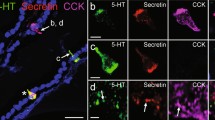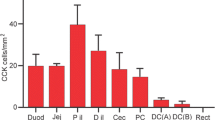Abstract
We use a monoclonal antibody against the C-terminal of oxyntomodulin (OXM) to investigate enteroendocrine cells (EEC) in mouse, rat, human and pig. This antibody has cross-reactivity with the OXM precursor, glicentin (Gli) but does not recognise glucagon. The antibody stained EEC in the jejunum and colon of each species. We compared OXM/Gli immunoreactivity with that revealed by antibodies against structurally related peptides, GLP-1 and glucagon and against GIP and PYY that are predicted to be in some EEC that express OXM/Gli. We used super-resolution to locate immunoreactive vesicles. In the pancreas, OXM/Gli was in glucagon cells but was located in separate storage vesicles to glucagon. In jejunal EEC, OXM/Gli and GIP were in many of the same cells but often in separate vesicles, whereas PYY and OXM/Gli were commonly colocalised in the same storage vesicles of colonic EEC. When binding of anti-GLP-1 to the structurally related GIP was removed by absorption with GIP peptide, GLP-1 and OXM/Gli immunoreactivities were contained in the same population of EEC in the intestine. We conclude that anti-OXM/Gli is a more reliable marker than anti-GLP-1 for EEC expressing preproglucagon products. Storage vesicles that were immunoreactive for OXM/Gli were almost always immunoreactive for GLP-1. OXM concentrations, measured by ELISA, were highest in the distal ileum and colon. Lesser concentrations were found in more proximal parts of small intestine and pancreas. Very little was in the stomach. In EEC containing GIP and OXM/Gli, these hormones are packaged in different secretory vesicles. Separate packaging also occurred for OXM and glucagon, whereas OXM/Gli and PYY and OXM/Gli and GLP-1 were commonly contained together in secretory vesicles.








Similar content being viewed by others
References
Ali Rachedi A, Varndell IM, Adrian TE, Gapp DA, Van Noorden S, Bloom SR, Polak JM (1984) Peptide YY PYY immunoreactivity is co-stored with glucagon related immunoreactants in endocrine cells of the gut and pancreas. Histochemistry 80:487–491
Bataille D (2007) Pro-protein convertases in intermediary metabolism: islet hormones, brain/gut hormones and integrated physiology. J Mol Med 85:673–684
Buchanan CM, Malik AS, Cooper GJS (2007) Direct visualisation of peptide hormones in cultured pancreatic islet alpha- and beta-cells by intact-cell mass spectrometry. Rapid Commun Mass Spectrom 21:3452–3458
Cho H-J, Robinson ES, Rivera LR, McMillan PJ, Testro A, Nikfarjam M, Bravo DM, Furness JB (2014) Glucagon-like peptide 1 and peptide YY are in separate storage organelles in enteroendocrine cells. Cell Tissue Res 357:63–69
Egerod KL, Engelstoft MS, Grunddal KV et al (2012) A major lineage of enteroendocrine cells coexpress CCK, secretin, GIP, GLP-1, PYY, and neurotensin but not somatostatin. Endocrinology 153:5782–5795
Field BCT, Wren AM, Peters V, Baynes KCR, Martin NM, Patterson M, Alsaraf S, Amber V, Wynne K, Ghatei MA, Bloom SR (2010) PYY3–36 and oxyntomodulin can be additive in their effect on food intake in overweight and obese humans. Diabetes 59:1635–1639
Fothergill LJ, Callaghan B, Hunne B, Bravo DM, Furness JB (2017) Costorage of enteroendocrine hormones evaluated at the cell and subcellular levels in male mice. Endocrinology 158:2113–2123
Gros L, Hollande F, Thorens B, Kervran A, Bataille D (1995) Comparative effects of GLP-1-(7-36) amide, oxyntomodulin and glucagon on rabbit gastric parietal cell function. Eur J Pharmacol Mol Pharmacol 228:319–327
Grunddal KV, Ratner CF, Svendsen B et al (2015) Neurotensin is co-expressed, co-released and acts together with GLP-1 and PYY in enteroendocrine control of metabolism. Endocrinology 157:176–194
Habib AM, Richards P, Cairns LS, Rogers GJ, Bannon CAM, Parker HE, Morley TCE, Yeo GSH, Reimann F, Gribble FM (2012) Overlap of endocrine hormone expression in the mouse intestine revealed by transcriptional profiling and flow cytometry. Endocrinology 153:3054–3065
Henderson SJ, Konkar A, Hornigold DC et al (2016) Robust anti-obesity and metabolic effects of a dual GLP-1/glucagon receptor peptide agonist in rodents and non-human primates. Diabetes Obes Metab 18:1176–1190
Holst JJ, Aggestrup S, Loud FB, Olesen M (1983) Content and gel filtration profiles of glucagon-like and somatostatin-like immunoreactivity in human fundic mucosa. J Clin Endocrinol Metab 56:729–732
Holst JJ, Albrechtsen NJW, Gabe MBN, Rosenkilde MM (2018) Oxyntomodulin: actions and role in diabetes. Peptides 100:48–53
Jorgensen R, Kubale V, Vrecl M, Schwartz TW, Elling CE (2007) Oxyntomodulin differentially affects glucagon-like peptide-1 receptor β-arrestin recruitment and signaling through Gαs. J Pharmacol Exp Ther 322:148–154
Jorsal T, Rhee NA, Pedersen J et al (2018) Enteroendocrine K and L cells in healthy and type 2 diabetic individuals. Diabetologia 61:284–294
Lopez LC, Li W-H, Frazier ML, Luo C-C, Saunders GF (1984) Evolution of glucagon genes. Mol Biol Evol 1:335–344
Lund A, Bagger JI, Albrechtsen NJW et al (2016) Evidence of extrapancreatic glucagon secretion in man. Diabetes 65:585–597
Mullen RJ, Buck CR, Smith AM (1992) NeuN, a neuronal specific nuclear protein in vertebrates. Development 116:201–211
Nishimura K, Hiramatsu K, Monir MM, Takemoto C, Watanabe T (2013) Ultrastructural study on colocalization of glucagon-like peptide (GLP)-1 with GLP-2 in chicken intestinal L-cells. J Vet Med Sci 75:1335–1339
Pocai A (2012) Unraveling oxyntomodulin, GLP1’s enigmatic brother. J Endocrinol 215:335–346
Pocai A (2014) Action and therapeutic potential of oxyntomodulin. Mol Metab 3:241–251
Ravazzola M, Orci L (1980) Glucagon and glicentin immunoreactivity are topologically segregated in the α granule of the human pancreatic α cell. Nature 284:66–67
Varndell IM, Bishop AE, Sikri KL, Uttenthal LO, Bloom SR, Polak JM (1985) Localization of glucagon-like peptide (GLP) immunoreactants in human gut and pancreas using light and electron microscopic immunocytochemistry. J Histochem Cytochem 33:1080–1086
Wewer Albrechtsen NJ, Kuhre RE, Toräng S, Holst JJ (2016) The intestinal distribution pattern of appetite and glucose regulatory peptides in mice, rats and pigs. BMC Res Notes 9:60
Acknowledgements
Insulin and glucagon antibodies were kindly provided by Prof Len Harrison. Confocal imaging was performed at the Biological Optical Microscopy Platform (BOMP), The University of Melbourne (www.microscopy.unimelb.edu.au). Ellie Cho (applications specialist, BOMP) provided valuable advice on experimental design and image analysis.
Funding
This work was supported by an Australian Government Research Training Program Scholarship to LJF.
Author information
Authors and Affiliations
Corresponding author
Ethics declarations
Conflict of interest
The authors declare that they have no conflict of interest.
Rights and permissions
About this article
Cite this article
Fothergill, L.J., Ringuet, M.T., Sioras, E. et al. Cellular and sub-cellular localisation of oxyntomodulin-like immunoreactivity in enteroendocrine cells of human, mouse, pig and rat. Cell Tissue Res 375, 359–369 (2019). https://doi.org/10.1007/s00441-018-2921-z
Received:
Accepted:
Published:
Issue Date:
DOI: https://doi.org/10.1007/s00441-018-2921-z




